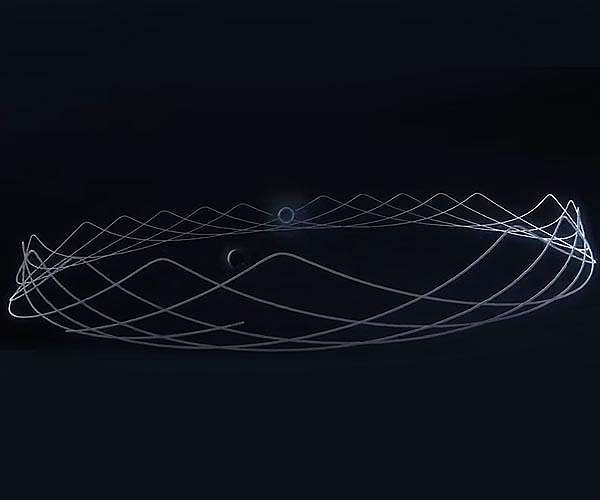A microwave oven-sized CubeSat dubbed CAPSTONE will blaze an untested, unusual yet efficient deep space route to the Moon that NASA is greatly interested in and future spacecraft may want to imitate.
The destination for CAPSTONE – short for the Cislunar Autonomous Positioning System Technology Operations and Navigation Experiment – is a unique lunar orbit intended for?NASA’s?Gateway, a multipurpose outpost that will provide essential support for long-term astronaut lunar missions as part of the Artemis program.
This special orbit, called a near rectilinear halo orbit, or NRHO, enables stability that translates to energy efficiency for Gateway’s minimum 15-year lifespan orbiting the Moon. CAPSTONE will be the first spacecraft to test the dynamics of NRHO once it arrives at the Moon following a four-month transit period. And while this gravity-driven track takes longer to reach the Moon, it will dramatically reduce the amount of fuel this pathfinder CubeSat will need to fly there.
The CAPSTONE team has virtually flown the CubeSat to NRHO through repeated tests in high fidelity computer simulations.
“Advanced Space used mature, flight-proven, NASA-derived simulation tools to develop, implement, and verify CAPSTONE’s mission trajectory and navigation approach,” said Tom Gardner, CAPSTONE program manager at Advanced Space of Westminster, Colorado.
Launch and Earth Escape
CAPSTONE is planned to launch no earlier than May 31 aboard Rocket Lab’s Electron rocket from the company’s Launch Complex 1 in Mahia, New Zealand. The CubeSat will start its mission joined with the Lunar Photon, an interplanetary third stage developed by Rocket Lab.
About 20 minutes after launch, the Lunar Photon – carrying CAPSTONE as a payload – will separate from Electron’s second stage at an altitude of 155 miles. After a short coast, Photon’s HyperCurie engine will then periodically ignite to increase its velocity and raise the highest point of its orbit to about 37,000 miles.
About six days after launch, a final ignition will accelerate Photon to 24,500 miles per hour to escape low-Earth orbit on a trajectory into deep space. Within 20 minutes of its final burn completion, Photon will release CAPSTONE into space for the first leg of the CubeSat’s solo flight to the Moon.
Fly Me to the Moon, as Efficiently as Possible
The CubeSat will rack up serious mileage hurtling through deep space on its traverse from Earth to the Moon. Assisted by the Sun’s gravity, it will reach a distance of 963,000 miles from Earth – more than three times the distance between Earth and the Moon – before being pulled back towards the Earth-Moon system.
This sinuous track – called a ballistic lunar transfer, or BLT – follows dynamic gravitational contours in deep space. CAPSTONE’s team will calculate the BLT trajectory based on the ever-changing positions of Earth, the Moon, and the Sun.
Expending little energy, CAPSTONE will cruise along these contours punctuated by a series of planned trajectory correction maneuvers. At critical junctures, CAPSTONE’s team at Advanced Space’s mission operations center will command the spacecraft to fire its thrusters to adjust course. Terran Orbital Corporation in Irvine, California, designed and built CAPSTONE and developed novel technology that allows the spacecraft to execute maneuvers while maintaining control of the spacecraft on thrusters only.
When CAPSTONE catches up to the Moon, its approach will be perfectly aligned for NRHO insertion, the crux of its route. While going 3,800 miles per hour, it will perform its delicate, precisely timed propulsive maneuver to enter orbit, like a flying trapeze artist who jumps from one arc to another with a decisive, acrobatic motion.
“We studied tens of thousands of computer simulations of the spacecraft’s transfer to the Moon,” said Ethan Kayser, CAPSTONE mission design lead at Advanced Space. CAPSTONE’s team used these simulations to optimally place the propulsive firings – used for course correction – to minimize the CubeSat’s fuel use and orbit insertion errors. “We also developed a unique, two-burn sequence to clean up errors after this sensitive insertion.”
BLT and orbit simulations also have allowed the team at Terran Orbital to prepare the spacecraft for any potential hiccups.
“The CAPSTONE spacecraft features a robust autonomous software design that allows it to recover from a variety of anomalies if one should occur,” said Marc Bell, co-founder, chairman, and CEO of Terran Orbital.
As no spacecraft has ever been placed in this type of orbit, CAPSTONE will lead the way for Gateway. Additionally, CAPSTONE’s mission will demonstrate multiple technologies that will lay a foundation for commercial support of future lunar operations.
Video: NASA’s CAPSTONE: Flying a New Path to the Moon
Related Links
CAPSTONE
Mars News and Information at MarsDaily.com
Lunar Dreams and more
| Tweet |
|
|
|
We need your help. The SpaceDaily news network continues to grow but revenues have never been harder to maintain. With the rise of Ad Blockers, and Facebook – our traditional revenue sources via quality network advertising continues to decline. And unlike so many other news sites, we don’t have a paywall – with those annoying usernames and passwords. Our news coverage takes time and effort to publish 365 days a year. If you find our news sites informative and useful then please consider becoming a regular supporter or for now make a one off contribution. |
||
|
SpaceDaily Contributor $5 Billed Once credit card or paypal |
SpaceDaily Monthly Supporter $5 Billed Monthly paypal only |
|
Lunar Reconnaissance Orbiter spots rocket impact site on Moon
Tempe AZ (SPX) Jun 24, 2022
Astronomers discovered a rocket body heading toward a lunar collision late last year. Impact occurred March 4, with NASA’s Lunar Reconnaissance Orbiter later spotting the resulting crater. Surprisingly the crater is actually two craters, an eastern crater (18-meter diameter, about 19.5 yards) superimposed on a western crater (16-meter diameter, about 17.5 yards).
The double crater was unexpected and may indicate that the rocket body had large masses at each end. Typically a spent rocket has mass c … read more

